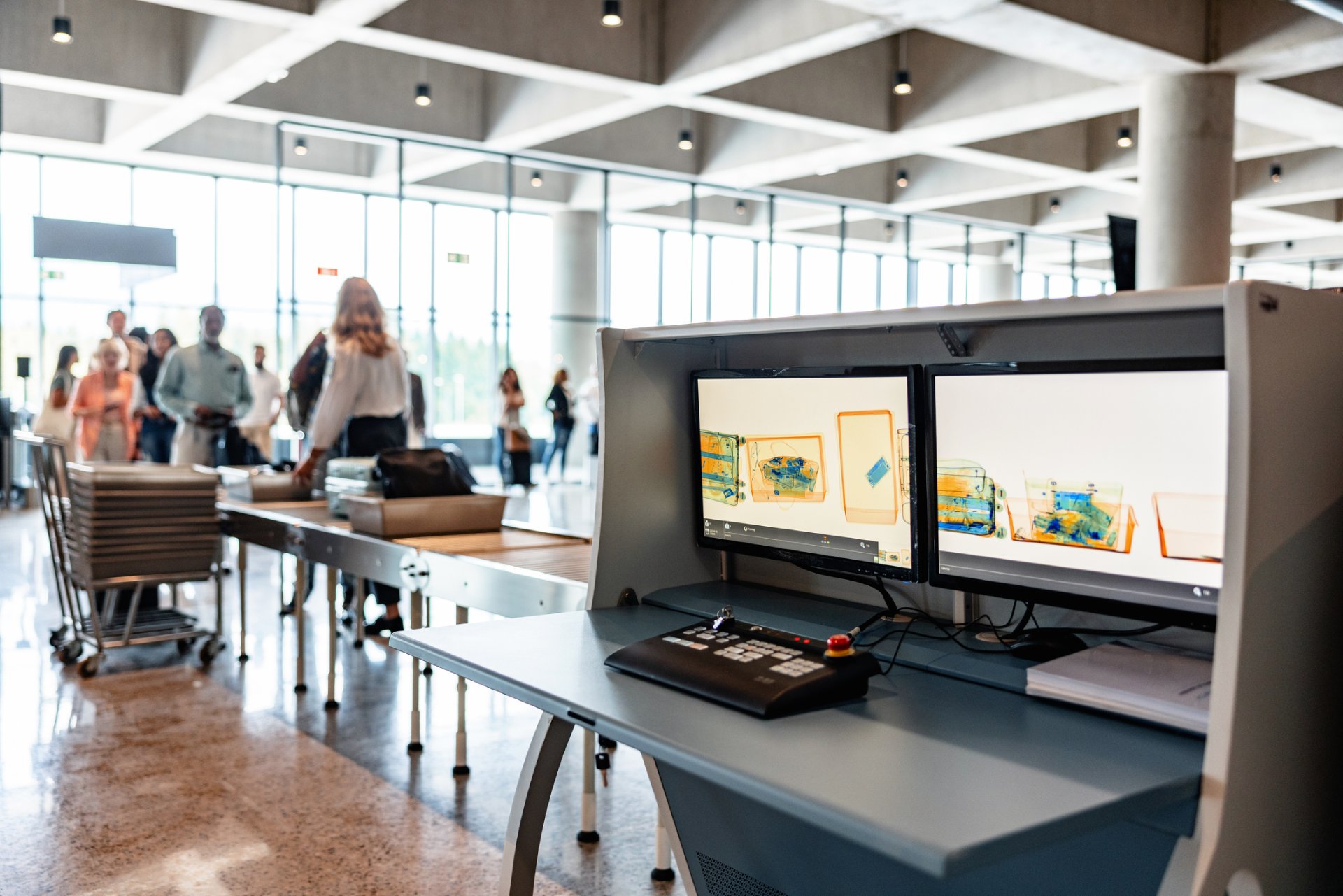Article Highlights
- AI in Airport Security: AI-powered systems are being tested to enhance threat detection, with potential deployment in international airports as early as 2025, streamlining security checks with advanced behavioral analysis.
- Computed Tomography (CT) Scanners: TSA’s CT scanners provide detailed 3D images of baggage, an advance over 2D images, allowing passengers to leave laptops and liquids in their bags, speeding up the screening process and increasing security accuracy.
- Biometric Security: Using biometrics, including facial recognition and fingerprints, allows for faster and more accurate identity verification, improving both security and the travel experience.
- TSA Touchless ID and Digital ID: Introduced a few years ago, these programs enhance airport security and traveler convenience using facial recognition and smartphone-based digital identification.
- Pros and Cons: While these technologies offer convenience, efficiency, and enhanced security, they raise concerns about privacy, data security, and limited availability at airports worldwide.
AI, Biometric Security, and CT Scanners: The Future of Airport Security
As AI, biometric security, and computed tomography (CT) scanners continue to evolve, they will likely become standard features of airport security. According to TSA Administrator David Pekoske, “It’s the future because it’s so much more effective than a manual comparison. This is better for security. It will be better for efficiency.”
These advancements offer significant advantages in terms of speed, convenience, and accuracy, though they come with challenges related to privacy, availability, and cost. Pekoske stressed privacy is at the forefront. “We don’t retain the data that you provide for more than a few seconds. We have no plans to surveil, and the technology is not capable of surveillance. So, our use case is to verify identity full stop, that’s it.”
The Role of AI in International Airport Security
AI-powered systems are expected to play a significant role in enhancing international security checks by 2025, with airports in Europe, the Middle East, and Asia leading the way in testing these technologies. Biometric programs are set to expand globally, with more countries adopting facial recognition and iris scanning as standard identification methods.
Artificial intelligence (AI) is increasingly being explored for use in airport security, with some of the early applications focusing on enhancing screening processes and threat detection. AI-powered systems can analyze vast amounts of data to identify suspicious behavior, patterns, or objects more quickly and accurately than traditional methods.
For example, AI could be used in behavioral analysis to detect unusual passenger movements or in conjunction with CT scanners to flag potential threats in luggage. AI systems are being tested in several airports globally, including Dubai International Airport and JFK International Airport in New York.
Biometric Security Programs and Their Expansion
Biometric security is becoming a cornerstone of airport safety. Biometric identifiers like fingerprints, iris scans, and facial recognition are increasingly replacing traditional IDs.
Countries like Japan, the UK, and the United States are leading the way in biometric security, with programs already deployed in several major airports. For example, CLEAR, a biometric security company operating in the U.S., allows travelers to use fingerprints or iris scans to clear airport security faster. Combined with TSA Pre-check, this program creates a seamless travel experience.
Internationally, airports in Hong Kong, Doha, and Singapore have been using biometric systems for years, and expansion is planned for the future.
TSA and CT Scanners in Airport Security
The introduction of computed tomography (CT) scanners is another significant advancement in airport security. TSA began deploying TSA CT scanners in 2019, and they are becoming more widespread in U.S. airports.
CT scanners allow security agents to get a 3D image of the contents of luggage, an improvement over 2D images, making it easier to detect prohibited items without requiring travelers to remove electronics or liquids from their bags. “These CT units represent sophisticated technology that helps our professional, dedicated, and highly skilled workforce detect new and evolving threats to improve aviation security. Deploying these units across our security checkpoints as expeditiously as possible will also improve checkpoint efficiency and the passenger experience,” said Pekoske.
CT scanners have been rolled out in major airports such as:
- John F. Kennedy International Airport (JFK)
- Hartsfield-Jackson Atlanta International Airport (ATL)
- Boston Logan International Airport (BOS)
Advantages of CT Scanners
- Improved Security: CT scanners provide clearer, more detailed images, allowing TSA agents to detect threats more accurately.
- Convenience for Travelers: Passengers no longer need to remove laptops, liquids, or other items from their bags, speeding up the security process.
- Reduced False Alarms: The advanced imaging technology helps reduce false positives, minimizing unnecessary secondary screenings.
Disadvantages of CT Scanners
- High Cost: Implementing CT scanners is expensive, which limits the speed at which they can be deployed across all airports.
- Initial Delays: While the technology speeds up security in the long term, the rollout process can cause delays as TSA agents and travelers adjust to the new system.
Evolving Beyond TSA PreCheck
TSA PreCheck has been successful in streamlining airport security for millions of travelers, offering expedited screening at more than 200 U.S. airports. Since its launch in 2013, TSA PreCheck has significantly reduced wait times, improved traveler satisfaction, and enhanced airport efficiency. The program’s success lies in its balance of convenience for travelers and maintaining high-security standards.
Today, airport security is undergoing more transformation with TSA Touchless ID and TSA Digital ID programs, introduced as part of the agency’s larger effort to enhance airport security and streamline the screening process.
How TSA Touchless ID and Digital ID Work
The Touchless ID program began rolling out in 2020 in response to the COVID-19 pandemic when there was a push for touchless technologies to reduce physical contact and the spread of germs at airports.
TSA Touchless ID uses biometric security, specifically facial recognition technology, to verify a traveler’s identity without requiring physical documents. Passengers at participating airports simply walk up to a camera that scans their faces. This scan is compared to the image on file, typically the one from their passport or driver’s license stored in a secure government database. If the images match, the passenger is cleared to proceed through security.
The TSA Digital ID, a more comprehensive system, followed in 2021, aimed at integrating digital verification into the travel experience. TSA Digital ID permits travelers to upload a digital version of their driver’s license or state ID into their smartphone. This ID is stored in a secure digital wallet, like Apple Wallet or Google Pay, and can be presented at TSA checkpoints using Near-Field Communication (NFC) technology or a QR code. The traveler taps their phone at a designated reader, and the TSA system verifies their identity digitally, reducing the need for a physical ID altogether.
Advantages of TSA Touchless ID and Digital ID for Travelers and Security
These new systems offer significant advantages, both for travelers and airport security operations.
For Travelers:
- Convenience and Speed: With Touchless ID and Digital ID, travelers no longer need to fumble with their physical identification documents. The verification process is faster and more efficient, allowing travelers to clear airport security quickly.
- Reduced Contact: In an era of heightened health awareness, touchless technology means fewer physical interactions, which can reduce the spread of germs at busy checkpoints.
- Enhanced Security: Digital IDs are less prone to being lost or stolen compared to physical IDs. Additionally, biometric security measures like facial recognition adds a layer of protection, as it’s difficult to fake biometric data.
For Security:
- Increased Accuracy: Biometric systems, particularly facial recognition, offer a high level of accuracy when verifying a traveler’s identity. This reduces the chances of identity fraud, a concern with traditional IDs.
- Efficiency: By speeding up the verification process, TSA can manage passenger flows more effectively, reducing long lines and wait times at busy airports.
- Enhanced Data Integration: TSA Digital ID allows for easier integration of passenger information across various security systems, improving the agency’s ability to monitor and respond to potential threats.
Disadvantages of TSA Touchless ID and Digital ID for Travelers
While these programs offer several advantages, there are also some downsides and concerns.
- Privacy Concerns: The use of biometric data, such as facial recognition, raises privacy concerns. Travelers may worry about how their data is stored, who has access to it, and how secure it is. The government holding sensitive biometric information can be unsettling for some.
- Limited Availability: As of 2024, TSA Touchless ID and TSA Digital ID are only available at select U.S. airports, limiting access for many travelers.
- Technological Barriers: Not all travelers are comfortable using digital systems. Additionally, smartphone-based Digital ID requires that travelers have a modern smartphone, which might not be the case for everyone.
- System Errors: Like any new technology, there’s the risk of glitches or system errors, which can cause delays and frustration for travelers. For example, if the facial recognition system fails to match a traveler’s face correctly, they may be forced to revert to traditional ID checks.
Airports Using TSA Touchless and Digital ID Systems
As of 2024, TSA Touchless ID and Digital ID programs are available at several U.S. airports, with plans for wider implementation. Key airports include:
- Hartsfield-Jackson Atlanta International Airport (ATL)
- Los Angeles International Airport (LAX)
- Dallas/Fort Worth International Airport (DFW)
- Miami International Airport (MIA)
- Ronald Reagan Washington National Airport (DCA)
Internationally, touchless biometric systems are being explored in major airports such as:
- Heathrow Airport (London)
- Changi Airport (Singapore)
- Schiphol Airport (Amsterdam)
The Global Rescue Connection
The best way to expedite airport security and gain peace of mind is through Trusted Traveler Programs. The integration of technologies like TSA Touchless ID, TSA Digital ID, biometric security, and computed tomography scanners represents a new era in airport security. As the aviation industry embraces AI and other cutting-edge technologies, the future of travel will likely become more secure and seamless for millions of travelers worldwide.
For all travelers, a Global Rescue medical evacuation and travel risk membership provides essential security. A Global Rescue membership covers the cost of field rescue or medical evacuation, which can soar up to $300,000 if you’re injured or ill abroad. For members, the price is $0—completely free. Without Global Rescue, emergencies may be slower, costlier, and more dangerous. As Global Rescue’s Dan Richards recently told Forbes, in today’s unpredictable world, travelers must be prepared to evacuate swiftly when needed.









